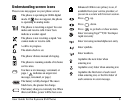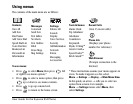Absorption Rates (SAR) can be found on the Cellular
Telecommunications and Internet Association (CTIA) web-
site at http://www.wow-com.com.
* In the United States and Canada, the SAR limit for
mobile phones used by the public is 1.6 watts/kg (W/kg)
averaged over one gram of tissue. The standard
incorporates a substantial margin of safety to give
additional protection for the public and to account for any
variations in measurements.
Caution
The user is cautioned that changes or modifications not
expressly approved by the party responsible for
compliance could void the warranty and user’s authority to
operate the equipment.
Warning
Use only Kyocera approved accessories with Kyocera
phones. Use of any unauthorized accessories may be
dangerous and will invalidate the phone warranty if said
accessories cause damage or a defect to the phone.
Optimize your phone’s performance
Use the guidelines on page 2 to learn how to optimize the
performance and life of your phone, antenna, and battery.
Air bags
If you have an air bag, DO NOT place installed or portable
phone equipment or other objects over the air bag or in
the air bag deployment area. If equipment is not properly
installed, you and your passengers risk serious injury.
Potentially unsafe areas
Posted facilities–Turn your phone off in any facility when
posted notices require you to do so.
Aircraft–FCC regulations prohibit using your phone on a
plane that is in the air. Turn your phone off before
boarding aircraft.
Vehicles–RF signals may affect improperly installed or
inadequately shielded electronic systems in motor
vehicles. Check with the manufacturer of the device to
determine if it is adequately shielded from external RF
energy. Your physician may be able to help you obtain this
information.
Blasting areas–Turn off your phone where blasting is in
progress. Observe restrictions, and follow any regulations
or rules.
Potentially explosive atmospheres–Turn off your phone when
you are in any area with a potentially explosive
atmosphere. Obey all signs and instructions. Sparks in
such areas could cause an explosion or fire, resulting in
bodily injury or death.
Areas with a potentially explosive atmosphere are often,
but not always, clearly marked. They include:
• fueling areas such as gas stations
• below deck on boats
• transfer or storage facilities for fuel or chemicals
• vehicles using liquefied petroleum gas, such as propane
or butane
• areas where the air contains chemicals or particles such
as grain, dust, or metal powders
• any other area where you would normally be advised to
turn off your vehicle engine
Use with care
Use only in normal position (to ear). Don’t bend the
antenna or touch it unnecessarily. Pull out the antenna
when on a call and push it in when the phone is not in use.
Avoid dropping, hitting, bending, or sitting on the phone.


















